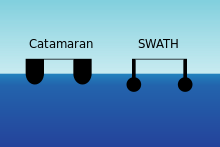Small-waterplane-area twin hull


A Small Waterplane Area Twin Hull, better known by the acronym SWATH, is a twin-hull ship design that minimizes hull cross section area at the sea's surface. Minimizing the ship's volume near the surface area of the sea, where wave energy is located, maximizes a vessel's stability, even in high seas and at high speeds. The bulk of the displacement necessary to keep the ship afloat is located beneath the waves, where it is less affected by wave action. Wave excitation drops exponentially as depth increases (Deeply submerged submarines are normally not affected by wave action at all). Placing the majority of a ship's displacement under the waves is similar in concept to creating a ship that rides atop twin submarines.
Effects
The twin-hull design provides a stable platform and large, broad decks. The main disadvantages of SWATH watercraft are that they are more expensive than conventional catamarans or mono-hulls, require a complex control system, have a deeper draft, and have higher maintenance requirements. The design of SWATH vessels is also considerably more complex due to the structural complexities inherent to the design. Additionally, SWATH vessels cannot operate in planing or semi-planing modes and as such gain no drag reduction when operating at speeds normally associated with such modes. This marginally limits SWATH speed when compared to equivalent catamaran vessels.[1]
History
The SWATH form was invented by Canadian Frederick G. Creed, who presented his idea in 1938, and was later awarded a British patent for it in 1946. The first full-scale SWATH vessel to be built and put into productive service was MV Duplus,[2] a diving support vessel built in the Netherlands in 1968. In the 1970s, several units were built in different countries (including SSC Kaimalimo by the US Navy, and an 80-ft ferry in Japan). Since the 1980s, oceanographic research vessels, pilot tenders, yachts and other craft are more routinely being built with the SWATH hull type.
Swath Ocean Systems Incorporated
Swath Ocean Systems Incorporated of San Diego, California (later Swath Ocean Systems LLC) manufactured these ships from 1979 to 2008 (the company folded sometime after this).
Specific examples

- Skrunda-class patrol boat
- Duplus (1969), an oil industry support ship
- CCGS Frederick G. Creed, a Canadian Coast Guard survey ship
- Sea Shadow, a US Navy experimental stealth ship
- Sea Fighter, a US Navy experimental littoral combat ship
- MV China Star (formerly the Radisson Diamond): a 350-person all balcony luxury cruise ship, the largest SWATH ship in the world when it was built, displacing more than 11,500 tons.
- SunCruz VI, a USCG certificated casino vessel for 600 passengers
- RV Kilo Moana (T-AGOR-26), a University of Hawaii oceanographic research vessel
- Cloud X, a passenger ferry running between Florida and the Bahamas
- Nekton Pilot/Swacat, an 80-foot cruise ship operated by Nekton Diving Cruises
- {21AA9C41-49F4-4421-9330-F448E37786D1} Cetus and Perseus, pilot vessels for the Netherlands Loodswezen
- Döse, Dunen, pilot vessels for the German Brotherhood of Elbe - Pilots
- Elbe, pilot station vessel for the German Brotherhood of Elbe - Pilots
- Planet Type 752, weapons + sonar research ship of the German Navy
- Western Flyer a Monterey Bay Aquarium Research Institute (MBARI) research vessel
- The Goya, a fictional vessel in Dan Brown's book Deception Point
- USNS Impeccable (T-AGOS-23), a U.S. Navy Impeccable-class ocean surveillance ship
- Silver Cloud, a 135' private yacht.
See also
- Multihull
- M80 Stiletto
- Catamaran
- Sea Slice, an experimental US Navy ship based upon the related technology called "SLICE".
- Semisubmersible
- Hydroairy ship, another twin hull design
- Trimaran
- wave-piercing
References
- Arps, Jan L. (29 Apr 1973 - 2 May). "The Role of the Semi-Submersible Work Vessel In Offshore Production Operations". Fifth Annual Offshore Technology Conference (Offshore Technology Conference). doi:10.4043/1867-MS. ISBN 978-1-55563-659-3.
Footnotes
- ↑ British Columbia Ferry Corporation: "Fast Ferries Technical Notes" 1995
- ↑ "Boele-Bolnes launch twin-hull craft for offshore work". Holland Shipbuilding 17 (9): 58. 1968.
External links
| Wikimedia Commons has media related to SWATH. |